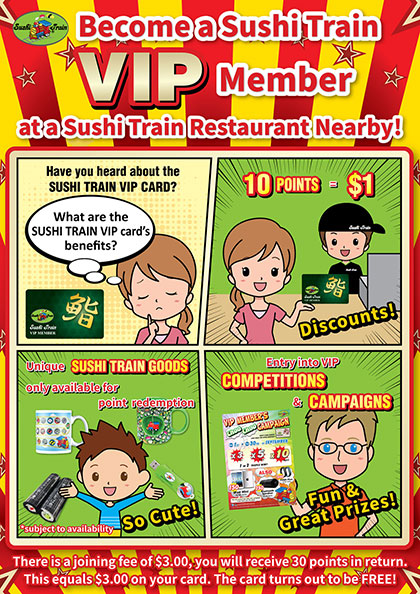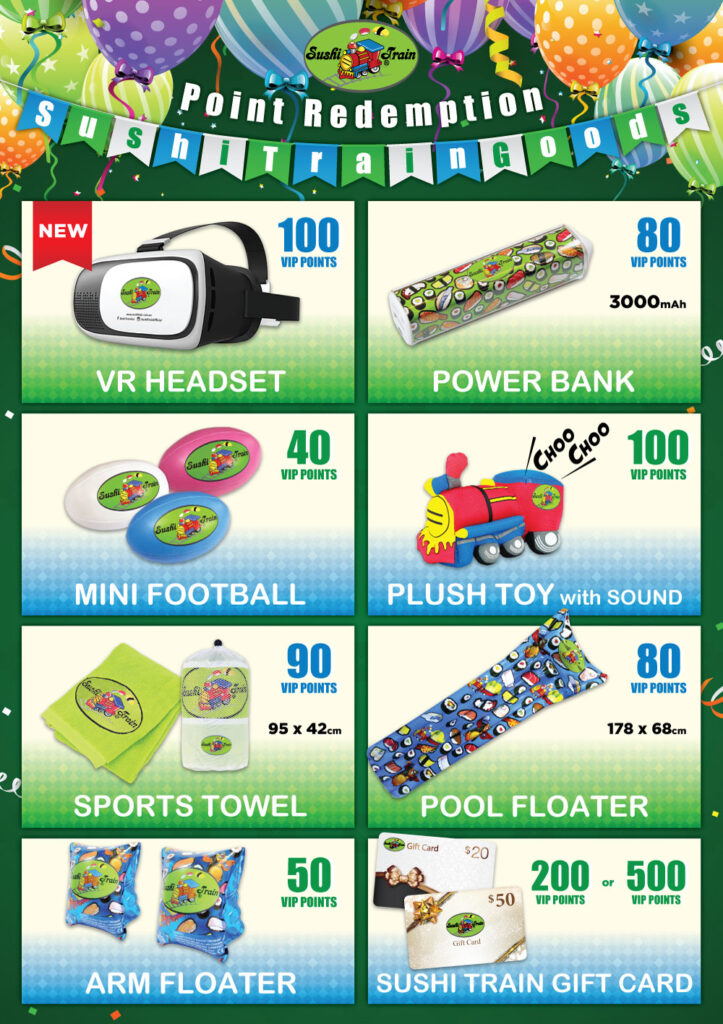
Sushi Train is a fun and interactive dining experience, and it’s also the name of a restaurant in Australia and New Zealand. There are 46 Sushi Train restaurants in Australia and 2 in New Zealand, all serving fresh dishes of great quality.
For those new to Sushi Train, it’s a popular concept originating in Japan, where Japanese dishes – primarily sushi – are served on a conveyer belt, allowing customers to select their preferred items as they pass by. Sushi Train operates a points-based loyalty program for their customers.
How to join
To join Sushi Train’s loyalty program, members must download the Sushi Train app.
They must create an account and share their first/last name, mobile, postcode, email and then create a password. Once members have created an account, they become a Sushi Train VIP member.
Earning points
- Members earn 1 point for every $2 spent at Sushi Train restaurants
- 10 points = $1 in value at Sushi Train, effectively giving members a 5% credit on their purchases

Credit based loyalty programs
One advantage of offering credits over discounts is that credits are often perceived as more tangible (a specific dollar figure visible in the member’s account vs an unallocated percentage). Credits, which the member has earned and feels ownership over, may be more likely to tap into the endowment effect and loss aversion biases. This means members may be more reluctant to lose access to their credits compared to a discount (Shelper, 2020)1.
Loyalty consultants at Loyalty & Reward Co theorise that members engage in mental accounting of the available credit and association with the brand, so they are more easily able to justify spending more money there (Shelper, 2020).
Redeeming points
Points can be redeemed for gift cards, credit to spend on future meals at Sushi Train, or on Sushi Train merchandise. The latter includes branded items like VR headsets, power banks, mini footballs, plush toys, sports towels, and pool toys. Though some members may enjoy this merchandise, ultimately, it is not complimentary to the brand. Instead, Sushi Train’s loyalty program should offer rewards that are more relevant to their brand such as chopsticks, Japanese style plates and bowls, and canisters to store green tea leaves.

Sushi Train app
The Sushi Train app has four tabs:
- Store locator: helps members find nearby Sushi Train restaurants and shows their menu and prices
- VIP Card with Barcode: displayed at checkout for scanning to earn points. It also highlights the promotions available
- Order history: allows members to keep track of their past orders in case they want to re-order a dish they previously had
- Personal profile: manages member account details
The VIP Card barcode simplifies the process of earning points by collecting transaction data at checkout.
Points dispute
From my personal experience, I have ordered from Sushi Train and scanned my app at checkout, but the points did not register. The FAQs do not mention anything related to points disputes.
Monthly promotions based on Japanese culture and history
Sushi Train has a promotion on Friday 24th May where all plates at a singular restaurant are $3.50 each. However, this promotion is not reflected on the app and is only relevant to members residing near that specific restaurant. At the time of writing this blog, the app shows no promotions.
To stimulate member’s engagement, Sushi Train could offer monthly specials based on Japanese culture and history, available at all 46 restaurants. Similarly, the popular frozen yoghurt brand Yo-Chi offers monthly promotions related to their brand as part of their loyalty program strategy. Read about their loyalty program here.
For example, Japan has a public holiday on May 5th known as Children’s Day which celebrates the happiness and healthy growth of children. On this day, families display flags in the shape of carp fish outside their homes, which look as if they are swimming as they flutter in the breeze. As carp can swim upstream, they symbolise courage and determination.
As part of Sushi Train’s loyalty program, a special promotion in May could offer all children one free dessert with their meal, celebrating Children’s Day and engaging members with a culturally meaningful offer. The app could provide a short description of the holiday and explain its significance. And for a special touch, all Sushi Train restaurants could display the carp-shaped flags outside their restaurants.
Monthly promotions based on Japanese culture are not only complimentary to the brand but also serve to engage members by encouraging them to open the app to check out the latest deal. Additionally, these unique offers differentiate the restaurant chain from its competitors, and help members form an emotional connection to the brand.
Japan has a rich history, and many people are engaged and fascinated in their culture. Sushi Train can leverage this interest and incorporate it in their loyalty program design.

Concluding thoughts…
Overall, Sushi Train’s loyalty program design is standard. The point system is straightforward, and the 5% credit on meals for future purchases, while not extraordinary, is a good incentive that encourages members to return and eat again. However, the program could benefit from enhancements to prevent it from becoming stagnant. Many loyalty programs exist where a large percentage of the member base have partially or fully disengaged because members no longer perceive there is meaningful value to be gained (Shelper, 2020).
The 5% credit alone may not be enough to maintain member interest and prevent members from deleting the app. Given that the average consumer in Australia, US, South Korea, and Japan has over 100 apps on their smartphone (App Annie)2, Sushi Train needs to provide compelling reasons for members to open their app and stay engaged. Introducing monthly promotions related to Japanese culture could significantly boost engagement and add a unique, culturally enriching aspect to Sushi Train’s loyalty program.
Do you want to revamp your loyalty program?
Our customer loyalty consultants design award-winning loyalty program strategies and can enhance your existing program to make sure you leveraging as many of the Essential Eight™ principles of best-practice loyalty programs as possible. Explore our wide range of comprehensive loyalty services or get in touch to talk with our loyalty experts to uncover your loyalty program X-factor.
Reference list

